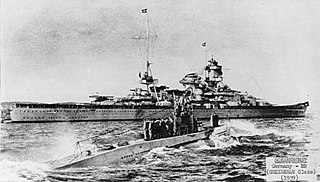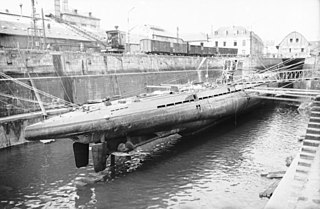
German submarine U-27 was a Type VIIA U-boat of Nazi Germany's Kriegsmarine built for service in World War II. Her keel was laid down in November 1935 in Bremen. She was commissioned in August 1936 with Korvettenkapitän Hans Ibbeken in command. Ibbeken was relieved on 4 October 1937, by Johannes Franz, who commanded the boat until 6 June 1939 when Hans-Georg von Friedeburg assumed command for barely one month. He was relieved on 8 July again by Johannes Franz, who commanded the boat until her loss on 20 September 1939.

German submarine U-47 was a Type VIIB U-boat of Nazi Germany's Kriegsmarine during World War II. She was laid down on 25 February 1937 at Friedrich Krupp Germaniawerft in Kiel as yard number 582 and went into service on 17 December 1938 under the command of Günther Prien.
German submarine U-28 was a Type VIIA U-boat of Nazi Germany's Kriegsmarine during World War II.

German submarine U-32 was a Type VIIA U-boat of Nazi Germany's Kriegsmarine during World War II.

German submarine U-33 was a Type VIIA U-boat of Nazi Germany's Kriegsmarine during World War II.

German submarine U-36 was a Type VIIA U-boat of Nazi Germany's Kriegsmarine which served during World War II. She was constructed in the earliest days of the U-boat arm at Kiel in 1936, and served in the pre-war Navy in the Baltic Sea and North Sea under Kapitänleutnant (Kptlt.) Klaus Ewerth. Korvettenkapitän (K.Kapt.) Wilhelm Fröhlich took command in October 1938 and continued in the role until the boat was lost.

German submarine U-49 was a Type VIIB U-boat of Nazi Germany's Kriegsmarine during World War II. She was ordered on 21 November 1936 and laid down on 15 September 1938 at the yards of Friedrich Krupp Germaniawerft AG in Kiel as yard number 584. Launched on 24 June 1939, she was commissioned on 12 August and assigned to the 7th U-Boat Flotilla under the command of Kurt von Goßler.
German submarine U-31 was a Type VIIA U-boat of Nazi Germany's Kriegsmarine during World War II. She was laid down on 1 March 1936 as yard number 912, launched on 25 September and commissioned on 28 December 1936.

German submarine U-38 was a Type IXA U-boat of Nazi Germany's Kriegsmarine that operated during World War II.

German submarine U-37 was a Type IXA U-boat of the German Navy (Kriegsmarine) during World War II. The submarine was laid down on 15 March 1937 at the DeSchiMAG AG Weser yard in Bremen, launched on 14 May 1938, and commissioned on 4 August 1938 under the command of Kapitänleutnant Heinrich Schuch as part of the 6th U-boat Flotilla.

The German submarine U-41 was a Type IXA U-boat of Nazi Germany's Kriegsmarine that operated during World War II. She conducted three war patrols during her short career, two as part of the 6th U-boat Flotilla and one as part of the 2nd flotilla. U-41 also sank five enemy vessels for a total of 22,815 gross register tons (GRT); captured two more for a total of 2,073 GRT and damaged one other of 8,096 GRT.
German submarine U-759 was a Type VIIC U-boat of Nazi Germany's Kriegsmarine during World War II. The submarine was laid down on 15 November 1940 at the Kriegsmarinewerft yard at Wilhelmshaven, launched on 30 May 1942, and commissioned on 15 August 1942 under the command of Oberleutnant zur See Rudolf Friedrich.
German submarine U-30 was a Type VIIA U-boat of Nazi Germany's Kriegsmarine that served during World War II. She was ordered in April 1935 in violation of the Treaty of Versailles, which prevented the construction and commissioning of any U-boats for the German navy, and as part of the German naval rearmament program known as Plan Z. She sank the liner SS Athenia (1922) on 3 September 1939, under the command of Fritz-Julius Lemp. She was retired from front-line service in September 1940 after undertaking eight war patrols, having sunk 17 vessels and damaging two others. U-30 then served in a training role until the end of the war when she was scuttled. She was later raised and broken up for scrap in 1948.

German submarine U-35 was a Type VIIA U-boat of Nazi Germany's Kriegsmarine. She was built three years before the start of World War II. The submarine was laid down on 2 March 1936 by Friedrich Krupp Germaniawerft at Kiel, launched on 24 September 1936, and commissioned on 3 November that year under the command of Kapitänleutnant (Kptlt.) Klaus Ewerth. The U-boat was featured on the cover of Life magazine on 16 October 1939, as in the days preceding, it "courteously" rescued all the sailors of a Greek ship that it was about to sink.

German submarine U-101 was a Type VIIB U-boat of Nazi Germany's Kriegsmarine during World War II. She had a highly successful career.
German submarine U-62 was a Type IIC, U-boat of Nazi Germany's Kriegsmarine that served in World War II built by Deutsche Werke AG, Kiel and commissioned on 21 December 1939.

German submarine U-29 was a Type VIIA U-boat of Nazi Germany's Kriegsmarine during World War II.
German submarine U-65 was a Type IXB U-boat of Nazi Germany's Kriegsmarine during World War II. Over the course of six war patrols between 9 April 1940 and 28 April 1941, she sank twelve ships and damaged three others for a total loss of 88,664 gross register tons (GRT).
German submarine U-61 was a Type IIC U-boat of Nazi Germany's Kriegsmarine that served in the Second World War. It was built by Deutsche Werke AG, Kiel. Ordered on 21 June 1937, it was laid down on 1 October as yard number 260. It was launched on 15 June 1939 and commissioned on 12 August under the command of Oberleutnant zur See Jürgen Oesten.
German submarine U-146 was a Type IID U-boat of Nazi Germany's Kriegsmarineduring World War II. Her keel was laid down on 30 March 1940 by Deutsche Werke in Kiel as yard number 275. She was launched on 21 September 1940 and commissioned on 30 October with Eberhart Hoffmann in command.










